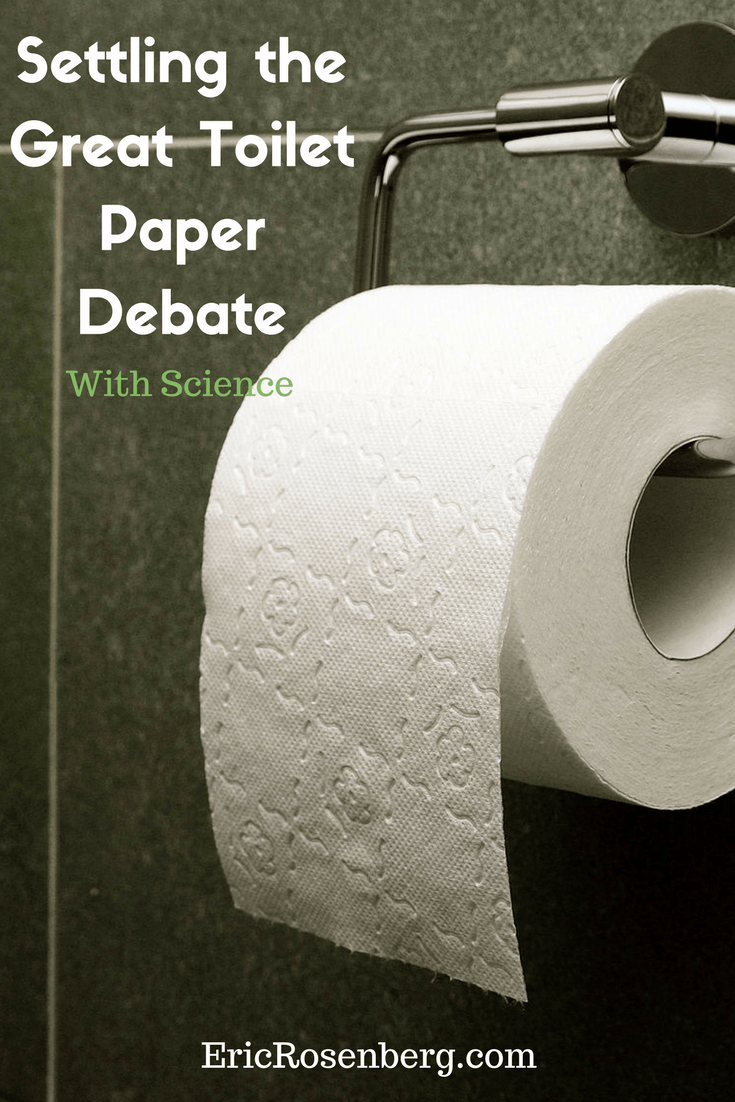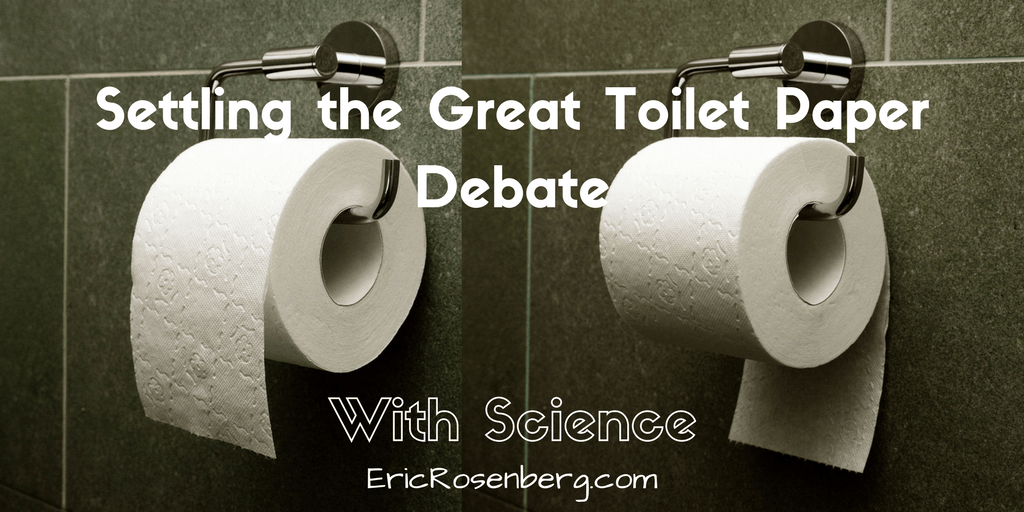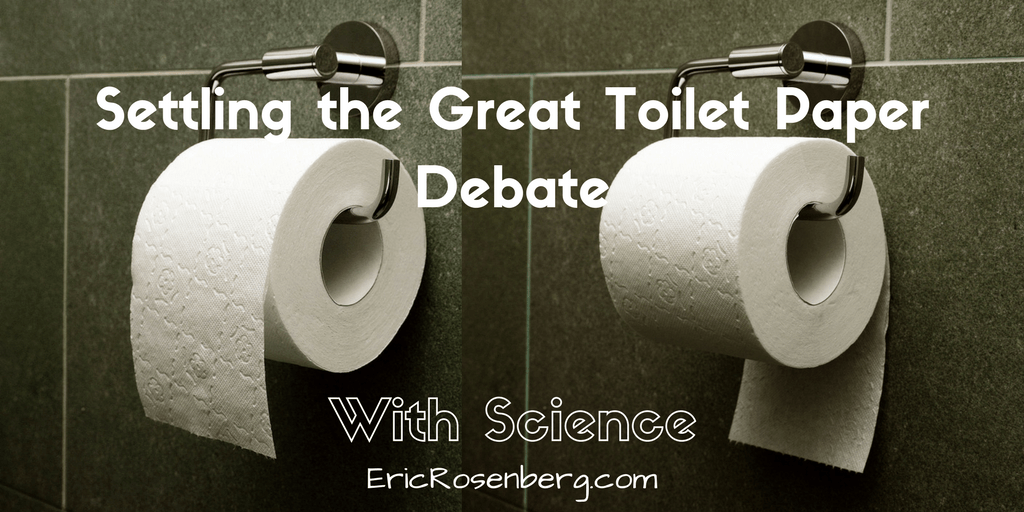There is a debate that has been a major part of our society for decades. Ever since the advent of modern toilet paper rolls, people around the world have had to make a serious decision. One that puts their entire moral fabric on display for visitors to their homes. The question: should the toilet paper hang over or under?
The History of Toilet Paper
The great toilet paper debate began with the invention of toilet paper. Toilet paper is defined by Wikipedia as “a soft tissue paper product primarily used for the cleaning of the anus to remove fecal material after defecation or to remove remaining droplets of urine from the genitals after urination.”
Something all users agree on is that toilet paper is preferable to the older method, wiping with the left hand. Toilet paper’s earliest recorded use was in 6th century China, over 1,500 years ago. It began mass production around 800 years later. Modern commercial toilet paper came into use in the 1800s, with the first roll-based dispenser patented in 1883.
With the toilet paper roll came the modern conundrum that led to this diatribe on toilet paper hanging. It’s a seemingly trivial topic but has potentially catastrophic ramifications. Just think, if your child grows up in a home with incorrectly positioned toilet paper, their social skills could fail to develop as intended.
Children who grow up in a home with improper toilet paper practices may feel out of place and ostracized by their peers. They may struggle through life, resenting the world around them. No one wants a non-functioning child or family member. Imagine if Kim Jong Un been reared in a household with toilet paper habits in line with the surrounding society. Maybe then he would have led his people to freedom and a new golden age of prosperity rather than following in the footsteps of his dictator father.
Are these broad, sweeping, and ludicrous claims? Of course they are. But that’s just how passionate some people are about this important issue our society deals with every daily.

Practical Applications of the Forward Hang
The proper placement of toilet paper is first an issue of utility, then an issue of décor. To begin, let’s consider the practical questions of toilet paper placement.
Hanging toilet paper forward has a major advantage over the backwards hang. The backwards hang may cause resting against a wall or clinging to the wall due to static electricity. With the forward hang, you can simply grab the toilet paper where you like.
When forward-facing, it’s easy to pull the toilet paper to the desired length and tear it with a quick tug. Depending on the dexterity of the toilet paper, the pulling motion may cause an undesired unrolling, but this is rare and generally caused by user error or a too-gentle tearing motion.
Practical Applications of the Under Hang
The backwards hang has a completely different tear style and method. With the reverse hang, it is necessary to use the wall for additional leverage when adjusting to the desired length. However, one potential benefit is that the tear can be completed with one hand using the press-and-tear method.
One risk with this method is that the quick tear will cause the user’s hand to brush against the wall. Depending on the wall material, this can cause bruising or a light scrape. While the risk of injury is small, it is worth noting.
A second practical reason to use the backward hang is if you are a pet owner, notably a cat owner, with a mischievous pet who regularly unravels the toilet paper roll onto the floor. This can cause a mess and make perfectly good toilet paper unusable. Though, as this 2006 video demonstrates, toilet paper, regardless of its orientation, is rarely safe from an ill-intentioned feline.
Another practical reason to use the backward hang is if your bathroom is in an RV or recreational vehicle. While driving over bumpy roads, forward-hanging toilet paper may slowly unroll onto the floor of the bathroom. No one wants to walk in and find this has happened at their greatest moment of need.
Visual Appeal
The next consideration when deciding on toilet paper placement is visual appeal. While a quality toilet paper dispenser makes a major impact on the overall artistic applications of your bathroom’s second most important object, after the toilet itself, it should not be overlooked that the roll placement can give an impression of a warm and welcoming home, just as posture and body language can impact social relations.
The forward hang is analagous to standing with open arms (metaphorically) during conversation. It conveys a welcoming attitude and openness to connect and befriend the person with whom you are interacting. When the toilet paper rolls over toward someone, it’s an inviting gesture and welcoming posture for your roll.
Conversely, a backwards roll projects a closed and unfriendly attitude. Like standing with your arms crossed, a reverse roll tells visitors of your facility that they are not as welcome.
For a final visual point, some toilet paper is printed with a pattern or design. In those instances, the print or pattern is always on the side so it is visible when hanging over the front of the roll. If placed in the backwards hang position the pattern is hidden and users are left looking at the backside, usually plain white, rather than the pattern, for which the facility owner paid a premium price.
Academia and Societal Trends
Several studies have been conducted regarding proper toilet paper orientation, and the results have been generally conclusive.
The primary academic source for this discussion comes from Eastern Institute of Technology sociology professor Alan Burns. Burns describes the debate as not a trivial pursuit in society, but rather a focus on the minor details which are often taken for granted but are an important piece of the “built-in-meta-narratives of society.” This makes them a powerful tool for examining connections to larger themes in society such as gender roles, the separation of public and private spheres, race and ethnicity, social class, and age.
University of Wisconsin professor Morton Ann Gernsbacher cautions that while preferences such as toilet paper hanging direction, the order of shampoo and soap use in the shower, and other personal habits generally have a strong popularity one way or the other, that this preference should not be taken into account as a method in which to discriminate against the minority, as has been done with other areas of segmenting the population in the past.
Manufacturer Georgia-Pacific commissioned the first widely quoted survey on the topic in 1993, and several have followed over the next decade. More unscientific polls have been conducted as recently as January 2010. It is important to note that the first major survey on the topic came five years earlier, in 1989, when authors Barry Sinrod and Mel Poretz took a wider survey on American habits and included one question on orientation, though it was not the primary focus of the study.
The Georgia-Pacific study found that of toilet paper users, 73% prefer the over, or forward hanging orientation. Later surveys were slightly more split, but in all major surveys, the majority of respondents prefer the forward hang.
- 1989 Poretz and Sinrod Survey – 68% preferred over
- 1994 Toilet Paper Report – 59% preferred over out of 1,000 respondents
- 1995 Bathroom Tissue Report – 59% preferred over compared to 29% who preferred under
- 2001 Bathroom Confidential – 63% preferred over
- 2004 Bathroom Confidential – 72% preferred over

This trend shows that after a substantial drop in the early 1990s, preference towards the forward hang has increased over time and has nearly surpassed the 1993 level. Users are now gravitating more towards the front hanging orientation than almost any time in the recorded history of toilet paper hanging preference.
The Sinrod and Poretz survey allowed for some additional statistical analysis which compared toilet paper habits to other socio-economic factors, such as gender, age, income, and politics.
The study showed that younger generations had a higher preference for the forward hang, with the highest concentrations in the 21-34 and 35-44 demographics. This leads one to extrapolate that in the coming generations, we will see a rise in the prevalence of the forward-hanging position. The noted outlier from this is females 55+, who have an 83% likelihood of preferring the forward hang.
Further analysis showed that 60% of those earning more than $50,000 per year prefer the front hang while 73% of those earning less than $20,000 per year prefer under. Sinrod did not have a great response on what that might prove. He said, “I don’t know, but it’s sure interesting.”
A Canadian poll in Saskatoon, Saskatchewan, coincidentally my Grandfather’s original hometown, found that 80% of local voters prefer a forward hang, noting that our friends to the north generally agree with us, possibly in higher numbers. In the Southern United States, a school science project conducted by a student at the Southern Appalachian Science and Engineering Fair in 1997 found that liberals generally prefer the forward roll while conservatives had more of a preference for the back-facing roll as reported by the Knoxville News-Sentinal. This survey clearly speaks for itself.
The implications toilet paper orientation has on future genocidal dictators aside, the issue has been a common friction point in both marriages and office environments, where one partner or worker has a strong opinion on the correctness of the hang that is contrary to that over their counterparts or peers. So clearly, a correct answer must be determined once and for all.
There is Only ONE Correct Way to Place Your Toilet Paper
Now that you have read the evidence and societal trends, we can finally put this contentious issue to rest.
There is only one correct way to place your toilet paper. And that is in the forward hanging orientation. That’s just science, and you can’t argue with science. I mean, you can try, but you will be branded as a religious zealot, and no one wants to be accused of zealotry.
This leaves one big question unanswered, however. What does one do with a vertically oriented toilet paper holder? Well, that is just a discussion for another day.




This is awesome, I always wondered about it 🙂 I am sharing that with my readers on Friday Oct 31st.
Glad you enjoyed it! Thanks for stopping by.
I know this article is old, but I’ll comment anyway. I’m proud to be in the minority on this. I generally find that my opinions coincide with those of the minority in polls. Fun article, by the way. Well written and funny.
Glad you enjoyed it! Never too late to comment. I have run into a few reverse toilet paper people. It’s amazing how passionate some people get about this, myself included.
I get aggravated when I see one hanging backwards. They are more likely to be torn wrong and more paper wasted. Even in public places, if procedure available, I turn them around as they should be. It is not just personality, but logic. (I worked in paper mills in several countries that made the tissue.)
I’d say that makes you a certified expert!
I found a sheet today12-22-16 in a business bathroom in Greenville MS that showed the great debate & led me to your webste. A few years ago I searched online to find info on the correct way to install tissue paper with a diagram for my business & could not find anything at that time. I am so excited to find all this info, it makes so much sense. I say a big thank you. Delton
I had thought that the debate was: wipe vs. wash
Ok, But see, a debate like that would end quite swiftly.
It would be akin to asking if it were better to wash your hands, or just wipe them with tissue/napkins
This is completely opinionated. Even the scientific studies we’re based on preference! WTH. The article is trash.
Anybody want to guess which way ‘Adam’ hangs the tissue.😄
Everytime I see a roll of toilet paper put on backwards. I think “What nut case did this”? Then I fix it before I use it. Worse than that is it sitting next to the sink on the counter getting wet!
The under hang is underrated and as scientific methodologies improve over time, I am sure my preferred hang will present more favorably. Who wants to use two hands to tear the toilet paper? Under is much better 😉
One point missed (at least I think it was missed as I only had time to skim the article, but I enjoyed the skim!) is that under allows one to pull away and UP a little, thus lessening the downward pull. Over the top, while allowing an outward pull, also forces the entire roll to absorb more downward pressure. Many times the roll can be caught or otherwise pinched and the upward pull allows just enough relief to not rip the paper prematurely. THIS, in my humble opinion, is worth noting. Besides, the cat thing. ha ha ha!!!!!
Rear-facing toilet paper is the mullet of the TP world, perhaps useful for something, but no one really knows what.
It is also impossible to fold the end of the roll into a cute triangle that hangs down, inviting you to pull. It’s how you dress a toilet paper roll.
Only a monster would hang it off the back.